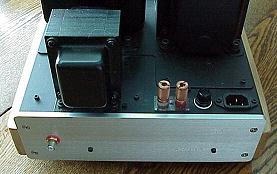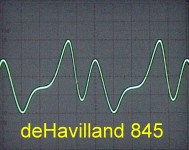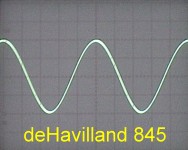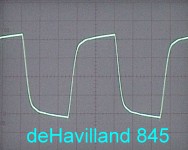Product Review - deHavilland 845
Single-Ended Pure Class A Triode Tube Monoblock Power Amplifiers - July, 2001
John E. Johnson, Jr.
![]()
 |
Specifications: Power: 25 Watts RMS into 8 Ohms MFR: 20 Hz - 35 kHz ± 3 dB Tube Complement: 6SN7 Input, 6AV5 Driver, 845 Output (One Each) Weight: 60 Pounds Each |
|
deHavilland Electric Amplifier Company, 1701 Santa Rosa Avenue, Santa Rosa, California 95404; Phone 707-527-6980; Fax 707-527-5009; E-Mail [email protected]; Web http://www.dehavillandhifi.com. |
Introduction
As all tubophiles know, the single-ended pure Class A triode produces a sound to die for. Unfortunately, triodes don't deliver much wattage. That is why tetrodes and pentodes were invented. To top it off, the very best quality comes from having just one triode in the output stage, not a bunch of them in parallel. The classic 300B is probably the best known triode, but it will only deliver about 10 watts or so.
Well, the 845 is another triode choice. It can produce several times what the 300B can. Of course, it means you need a bigger power supply too, so using the 845 does not mean less expensive, it may actually mean more. But, you get the power that you just can't have with a 300B.
deHavilland
Kara Chaffee and George Kielczynski made tube amplifiers for themselves, and then their friends asked them to make amplifiers for their homes, so they decided to start a company. deHavilland became the company name, with Kara as chief engineer and George as company president. The Aries 572 was an initial monoblock product, which has 35 watts pure Class A output. They MSRP at $5,995 for two monoblocks. The 845 is the new kid on the monoblock, rated at 25 watts pure Class A, and $4,995 the pair. You can see what I mean about big power supplies meaning big money. To get 25 watts output, the amplifier has to be able to dissipate about 75 watts at idle. So, the big power supply.
The Design
The 845 has just three tubes, a 6SN7 as input, 6AV5 as driver, and the 845 as output. Tube amplifiers usually have simple circuits, and the 845 is no exception. But, all that hand wiring from point-to-point, instead of using printed circuit boards everywhere, adds to the cost along with the power supply. The 845 tube has a bayonet mount, which means you push it into the socket and turn it, sort of like a BNC connector.
The rear panel (photo below) has all metal, gold plated speaker binding posts, the fuse, grounded AC socket, and a single RCA jack. You can also see that there are three transformers. One is for the high voltage, one is for the filament voltage, and one is for the output. When you power up the 845 with the front panel toggle, voltage is applied to the filaments first. Then about 30 seconds later, high voltage is applied to the plates. These two stages are indicated by two small lights on the front panel next to the on/off toggle.

There is a potentiometer for adjusting the bias voltage on the top of the chassis, near the tubes. Using a small screwdriver, you adjust it to between 0.6 Volts (DC) and 0.7 Volts (there are two small sockets to place the probes of a voltmeter into). I preferred the higher setting (0.7 Volts), and even though I played music at low levels, this still changed the character of the sound. Bias voltage is placed on the grid of the triode, and this produces current flow even at idle. When the music signal comes through, the current is sent to the speaker instantaneously. This is why Class A is so good. There is no time lag, as there is with Class A/B when going into Class B operation, and where the current has to be turned on (since it is not already flowing as it is with Class A).
In Use
I tested the 845 with an Audio Alchemy transport, Perpetual Technologies P-1A DCE and P-3A DAC, Balanced Audio VK-5i triode preamplifier, Krix Esoterix I Mk II speakers, and Nordost cables.
I was really not surprised at the sound. It is very warm, just as I would expect from a Class A triode. What I did not expect though, was the powerful bass. It was clean and deep, even tight. One of the criticisms of triodes has been a lack of bass, perhaps due to the low wattage that they can deliver. Not so with the 845. Having 25 watts, along with huge transformers, makes a big difference.
The treble is a bit laid back, like triode amplifiers tend to do. Some people do not like this, because it is not a flat response. The midrange is also lush, which makes up for the laid back highs. So, an amplifier like the 845 sounds wonderful with such things as voices. Again, some may object to the insertion of extra even-ordered harmonics. No, it is not high fidelity in the sense of being an exact replica of the input signal, except for amplitude. But, solid state amplifiers tend to insert odd-ordered harmonics, and even a very small amount of these harmonics can have an awful effect on the ears. Negative feedback can be used to reduce harmonic distortion, but it is not employed with the 845 at all, because (1) the 845 is more linear than transistors, and (2) even-ordered harmonics are pleasant to listen to. So, you have to decide which is more important: greater hi fidelity, or the pleasure of having more even-ordered harmonics. As an aside, deHavilland included a potentiometer on the 845 chassis at first, which let you add varying amounts of negative feedback. But once you hear its unpleasant result, you never use it again. So, they have eliminated the potentiometer from current production runs.
The 845 produces a typical result for a triode tube measured on an oscilloscope with a sine wave input, as shown in the photo below (10 kHz sine wave, ± 4 volts). What counts is the effect such behavior has on the ears. (Note: After the amplifiers were returned to deHavilland, they mentioned that the output is phase-reversed, and they have the red output post as ground and the black output post as hot. I measured the 845 with the usual technique of black probe to the black post and red probe to red post, which may explain the oscilloscope reading. The next time we have a deHavilland amplifier here, I will get the 845 again and photograph the oscilloscope reading both ways.)
Update: Here are the revised sine wave and square wave graphics. Kara Chaffee brought an 845 by the lab, and I measured the wave forms using the hot to black post and ground to red post. The reversed connection 10 kHz sine wave is on the left, the correct connection 10 kHz sine wave is in the middle, and the correct connection 10 kHz square wave is on the right. The 845 also measured to have a - 3 dB down point at 40 kHz, using a 10 kHz sine wave as reference. An SE amplifier will handle getting its hot connection shorted to ground, but a solid state amplifier would likely be damaged.
|
|
|
|
For listening to chamber music in the evening, such as Vivaldi and Mozart, or to sweet vocals like Enya, the 845 truly excels. However, I found that it also did just fine with such things as Mary Chapin Carpenter, which is played at louder levels. This is something that a single 300B just won't do (unless you have speakers that are very sensitive).
Conclusion
Having been used to the limitations of 300B triodes, but loving their sound, I was delighted to be able to audition the deHavilland 845 with its much higher power. The attributes of 300Bs are there, but with added weight in the bass and dynamic range. You could easily spend this kind of money on a 300B amplifier, and you can spend a lot more as well. So, at $4,995 the pair, the deHavilland 845 is a major player and a must-audition.
- John E. Johnson, Jr. -
![]()
© Copyright 2001 Secrets of Home Theater & High Fidelity
Return to Table of Contents for this Issue.




